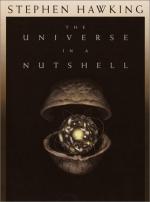
|
| Name: _________________________ | Period: ___________________ |
This test consists of 15 multiple choice questions and 5 short answer questions.
Multiple Choice Questions
1. How is the following quote finished: "The human race needs to improve its mental and physical qualities to deal with an...?"
(a) Interesting and diversive world.
(b) Increasingly complex world.
(c) Intuitive and diverse world.
(d) Increasingly simple world.
2. What can p-branes absorb?
(a) Shape.
(b) Thought.
(c) Particles.
(d) Stars.
3. How does Hawking state particle states be represented?
(a) With wave functions.
(b) With bell curves.
(c) With light functions.
(d) With satellite functions.
4. What does Hawking say might happen if humans don't destroy themselves?
(a) Humans will need to ration food.
(b) Humans will spread to other planets.
(c) Humans will find a way to live on the Earth forever.
(d) Humans will need to procreate rapidly.
5. What is determinism threatened by?
(a) Heisenberg uncertainty.
(b) Magical Realism.
(c) Walter's metaphysical drive.
(d) Hartford supertheory.
6. What would happen if energy escaped the black hole over time?
(a) Its temperature would rise.
(b) Its fragrance would emit.
(c) Its heat would escape as well.
(d) Its light would fragment.
7. How could time travel be possible?
(a) If speed was inverse to time.
(b) If time travel loops existed.
(c) If circular reasoning existed.
(d) If wormholes existed.
8. When particles hit p-branes, what are produced?
(a) Nothing is produced.
(b) Time bombs.
(c) Miniature explosions.
(d) Extra, multi-dimensional branes.
9. What kind of explanation does Hawking give for how it might be possible to travel through time?
(a) Superficial.
(b) Complex.
(c) General.
(d) Blanket statement.
10. What is Feynman's history idea called?
(a) Imaginary history idea.
(b) Singular history idea.
(c) Fictional history idea.
(d) Multiple history idea.
11. For nearly all of history, what has moved forward?
(a) The Earth.
(b) Spacetime.
(c) Energy.
(d) Humanity.
12. What final state does Hawking wonder if humanity will ever reach?
(a) Science and technology.
(b) Chemistry and physics.
(c) Ecology and biology.
(d) Geography and geology.
13. What is a practical limit on the design of faster computers?
(a) The weight of gravity.
(b) The speed of gravity.
(c) The acceleration of mass.
(d) The speed of light.
14. What famous quote is attributed to physicist John Wheeler?
(a) A black hole has two hairs.
(b) A black hole has no hair.
(c) A black hole is wearing a wig.
(d) A black hole is bald.
15. In what realm of physics is it important to consider the Schrodinger equation?
(a) Special theoretical physics.
(b) Medical theoretical physics.
(c) General theoretical physics.
(d) Contemporary theoretical physics.
Short Answer Questions
1. What is the name of Hawking's conjecture about the laws of physics and macroscopic time travel?
2. What kind of philosophy do black holes have?
3. What partially restores determinism as a view?
4. How can half-determinism be preserved in relation to black holes?
5. What question does Hawking ask about extraterrestrials?
|
This section contains 501 words (approx. 2 pages at 300 words per page) |

|




